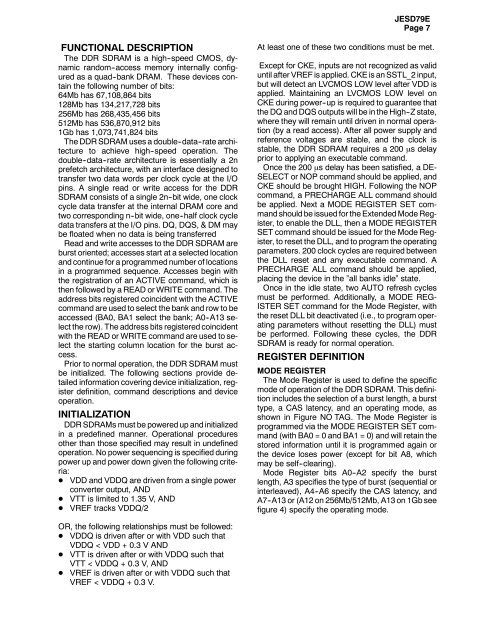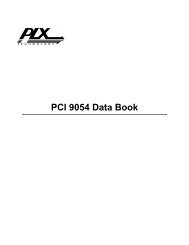Create successful ePaper yourself
Turn your PDF publications into a flip-book with our unique Google optimized e-Paper software.
JESD79E<br />
Page 7<br />
FUNCTIONAL DESCRIPTION<br />
The DDR SDRAM is a high--speed CMOS, dynamic<br />
random--access memory internally configured<br />
as a quad--bank DRAM. These devices contain<br />
the following number of bits:<br />
64Mb has 67,108,864 bits<br />
128Mb has 134,217,728 bits<br />
256Mb has 268,435,456 bits<br />
512Mb has 536,870,912 bits<br />
1Gb has 1,073,741,824 bits<br />
The DDR SDRAM uses a double--data--rate architecture<br />
to achieve high--speed operation. The<br />
double--data--rate architecture is essentially a 2n<br />
prefetch architecture, with an interface designed to<br />
transfer two data words per clock cycle at the I/O<br />
pins. A single read or write access for the DDR<br />
SDRAM consists of a single 2n--bit wide, one clock<br />
cycle data transfer at the internal DRAM core and<br />
two corresponding n--bit wide, one--half clock cycle<br />
data transfers at the I/O pins. DQ, DQS, & DM may<br />
be floated when no data is being transferred<br />
Read and write accesses to the DDR SDRAM are<br />
burst oriented; accesses start at a selected location<br />
and continue for a programmed number of locations<br />
in a programmed sequence. Accesses begin with<br />
the registration of an ACTIVE command, which is<br />
then followed by a READ or WRITE command. The<br />
address bits registered coincident with the ACTIVE<br />
command are used to select the bank and row to be<br />
accessed (BA0, BA1 select the bank; A0--A13 select<br />
the row). The address bits registered coincident<br />
with the READ or WRITE command are used to select<br />
the starting column location for the burst access.<br />
Prior to normal operation, the DDR SDRAM must<br />
be initialized. The following sections provide detailed<br />
information covering device initialization, register<br />
definition, command descriptions and device<br />
operation.<br />
INITIALIZATION<br />
DDR SDRAMs must be powered up and initialized<br />
in a predefined manner. Operational procedures<br />
other than those specified may result in undefined<br />
operation. No power sequencing is specified during<br />
power up and power down given the following criteria:<br />
D VDD and VDDQ are driven from a single power<br />
converter output, AND<br />
D VTT is limited to 1.35 V, AND<br />
D VREF tracks VDDQ/2<br />
At least one of these two conditions must be met.<br />
Except for CKE, inputs are not recognized as valid<br />
until after VREF is applied. CKE is an SSTL_2 input,<br />
but will detect an LVCMOS LOW level after VDD is<br />
applied. Maintaining an LVCMOS LOW level on<br />
CKE during power--up is required to guarantee that<br />
the DQ and DQS outputs will be in the High--Z state,<br />
where they will remain until driven in normal operation<br />
(by a read access). After all power supply and<br />
reference voltages are stable, and the clock is<br />
stable, the DDR SDRAM requires a 200 µs delay<br />
prior to applying an executable command.<br />
Once the 200 µs delay has been satisfied, a DE-<br />
SELECT or NOP command should be applied, and<br />
CKE should be brought HIGH. Following the NOP<br />
command, a PRECHARGE ALL command should<br />
be applied. Next a MODE REGISTER SET command<br />
should be issued for the Extended Mode Register,<br />
to enable the DLL, then a MODE REGISTER<br />
SET command should be issued for the Mode Register,<br />
to reset the DLL, and to program the operating<br />
parameters. 200 clock cycles are required between<br />
the DLL reset and any executable command. A<br />
PRECHARGE ALL command should be applied,<br />
placing the device in the ”all banks idle” state.<br />
Once in the idle state, two AUTO refresh cycles<br />
must be performed. Additionally, a MODE REG-<br />
ISTER SET command for the Mode Register, with<br />
the reset DLL bit deactivated (i.e., to program operating<br />
parameters without resetting the DLL) must<br />
be performed. Following these cycles, the DDR<br />
SDRAM is ready for normal operation.<br />
REGISTER DEFINITION<br />
MODE REGISTER<br />
The Mode Register is used to define the specific<br />
mode of operation of the DDR SDRAM. This definition<br />
includes the selection of a burst length, a burst<br />
type, a CAS latency, and an operating mode, as<br />
shown in Figure NO TAG. The Mode Register is<br />
programmed via the MODE REGISTER SET command<br />
(with BA0 = 0 and BA1 = 0) and will retain the<br />
stored information until it is programmed again or<br />
the device loses power (except for bit A8, which<br />
may be self--clearing).<br />
Mode Register bits A0--A2 specify the burst<br />
length, A3 specifies the type of burst (sequential or<br />
interleaved), A4--A6 specify the CAS latency, and<br />
A7--A13 or (A12 on 256Mb/512Mb, A13 on 1Gb see<br />
figure 4) specify the operating mode.<br />
OR, the following relationships must be followed:<br />
D VDDQ is driven after or with VDD such that<br />
VDDQ < VDD + 0.3 V AND<br />
D VTT is driven after or with VDDQ such that<br />
VTT < VDDQ + 0.3 V, AND<br />
D VREF is driven after or with VDDQ such that<br />
VREF < VDDQ + 0.3 V.




